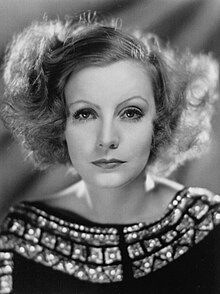
Back Greta Garbo Afrikaans Greta Garbo AN غريتا غاربو Arabic جريتا جاربو ARZ Greta Garbo AST Greta Garbo Aymara Qreta Qarbo Azerbaijani قرتا قاربو AZB Грета Гарбо Bashkir Greta Garbo BAR
Greta Garbo | |
|---|---|
 Garbo in Inspiration (1931) | |
| Born | Greta Lovisa Gustafsson 18 September 1905 Stockholm, Sweden |
| Died | 15 April 1990 (aged 84) New York City, U.S. |
| Resting place | Skogskyrkogården Cemetery, Stockholm |
| Citizenship |
|
| Alma mater | Royal Dramatic Training Academy |
| Occupation | Actress |
| Years active | 1920–1941 |
| Signature | |
Greta Garbo[a] (born Greta Lovisa Gustafsson;[b] 18 September 1905 – 15 April 1990) was a Swedish-American[1] actress and a premiere star during Hollywood's silent and early golden eras. Regarded as one of the greatest screen actresses of all time, she was known for her melancholic and somber screen persona, her film portrayals of tragic characters, and her subtle and understated performances. In 1999, the American Film Institute ranked Garbo fifth on its list of the greatest female stars of classic Hollywood cinema.
Garbo launched her career with a secondary role in the 1924 Swedish film The Saga of Gösta Berling. Her performance caught the attention of Louis B. Mayer, chief executive of Metro-Goldwyn-Mayer (MGM), who brought her to Hollywood in 1925. She stirred interest with her first American silent film, Torrent (1926). Garbo's performance in Flesh and the Devil (1926), her third movie, made her an international star.[2] In 1928, Garbo starred in A Woman of Affairs, which catapulted her to MGM's highest box-office star, surpassing the long-reigning Lillian Gish. Other well-known Garbo films from the silent era are The Mysterious Lady (1928), The Single Standard (1929), and The Kiss (1929).
With Garbo's first sound film, Anna Christie (1930), MGM marketers enticed the public with the tagline "Garbo talks!" That same year she starred in Romance and for her performances in both films she received her first combined nomination out of three nominations for the Academy Award for Best Actress.[3] By 1932 her success allowed her to dictate the terms of her contracts and she became increasingly selective about her roles. She continued in films such as Mata Hari (1931), Susan Lenox (Her Fall and Rise) (1931), Grand Hotel (1932), Queen Christina (1933), and Anna Karenina (1935).
Many critics and film historians consider her performance as the doomed courtesan Marguerite Gautier in Camille (1936) to be her finest and the role gained her a second Academy Award nomination. However, Garbo's career soon declined and she became one of many stars labelled box office poison in 1938. Her career revived with a turn to comedy in Ninotchka (1939), which earned her a third Academy Award nomination. But after the failure of Two-Faced Woman (1941), she retired from the screen at the age of 35 after acting in 28 films. In 1954, Garbo was awarded an Academy Honorary Award "for her luminous and unforgettable screen performances".[4]
After retiring, Garbo declined all opportunities to return to the screen, shunned publicity, and led a private life. She became an art collector whose paintings included works by Pierre-Auguste Renoir, Pierre Bonnard and Kees van Dongen.[5]
Cite error: There are <ref group=lower-alpha> tags or {{efn}} templates on this page, but the references will not show without a {{reflist|group=lower-alpha}} template or {{notelist}} template (see the help page).
- ^ "1951 Greta Garbo becomes U.S. citizen... - RareNewspapers.com". www.rarenewspapers.com. Archived from the original on 13 November 2021. Retrieved 13 November 2021.
- ^ Vieira 2005, p. 38.
- ^ "Session Timeout – Academy Awards® Database – AMPAS". Archived from the original on 3 November 2013.
- ^ "The Official Academy Awards Database". Archived from the original on 8 February 2009. Retrieved 13 July 2010.
- ^ Reif, Rita (19 July 1990). "Garbo's Collection and a van Gogh Are to Be Sold". The New York Times. Archived from the original on 31 December 2019. Retrieved 11 October 2015.
© MMXXIII Rich X Search. We shall prevail. All rights reserved. Rich X Search